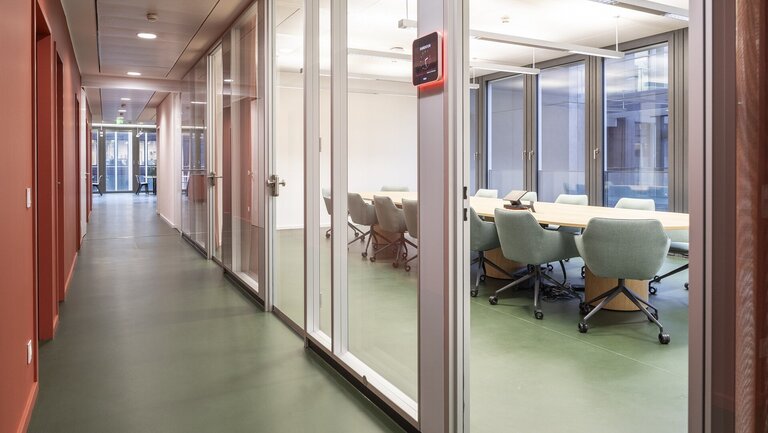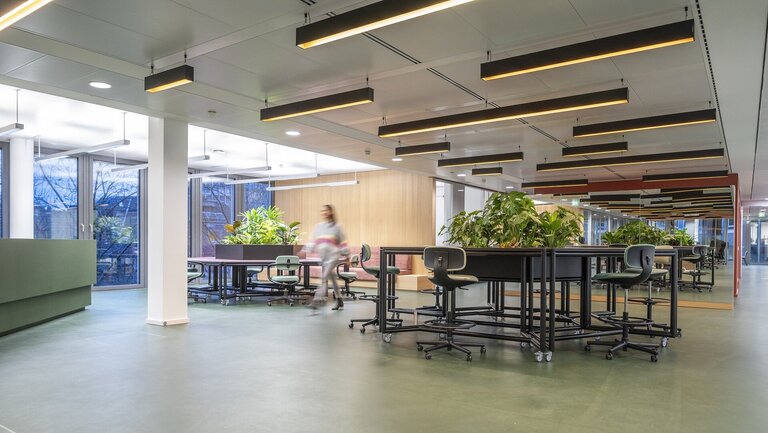Cologne, Germany, November 30, 2023. Paper clips, hole punch and pen holders, formerly symbols of everyday office life, have long been relics of a bygone era. The same applies to pure open-plan offices or rigid individual cubicle structures. Since offices have existed, people have had to reinvent them again and again, adjusting their working environments to the times they were living in. The question now facing many companies post-pandemic, with the widespread adopting of remote working from home, is how to entice employees back into the office. The answer of the Cologne-based staff of consultancy firm Drees & Sommer SE, which specializes in construction and real estate, is as follows: ‘Make the office somewhere they will want to spend time’. Based loosely on this ideal, a new integrated office layout geared to the needs of users has been created in an existing building, taking advantage of the full potential of the rental space. Yesterday, the company’s staff celebrated the inauguration of their newly designed work environment.
More than 13 years have passed since the topping-out ceremony for the seven-story Westgate building on Rudolfplatz in the center of Cologne. Its name refers to a place steeped in history: next to the Westgate, German kings used to arrive at Cologne Cathedral via the medieval Hahnentorburg gatehouse. The fully let office and commercial property of the asset management company MEAG has a gross rental space of 20,100 square meters. Tenants of the ground floor are food and beverage outlets and retail shops. There are 17,400 square meters of office area. Drees & Sommer’s Cologne office has been located in the Westgate building for ten years. The company provides advice in the fields of construction and real estate. The around 260-strong team occupies almost the entire space of around 2,700 square meters on the fifth floor of the complex.
Magnet for Employees and Flagship for Resource-Conserving Alteration Work
Stefan Heselschwerdt, Partner at Drees & Sommer SE and responsible for the activities in the German federal state of North Rhine-Westphalia explained: "When we were considering how we could make the working environment in our Cologne location fit for the future, it soon became clear that the ideal place was the existing space in the Westgate building, which we had been renting for a long time. This was not only because we like it so much there and we benefit from the building’s unique central location with good public transport links, but also because altering an existing building conserves resources. So, at the beginning of the year we extended our rented space by 370 square meters and embarked on a comprehensive redesign project."
Drees & Sommer formed an internal interdisciplinary project team. The four team members were responsible for managing and planning the modernization of the office environment. "We not only wanted to give the premises a new look. It was our ambition that the office would continue to be a magnet for our employees, and moreover become a flagship for an innovative, resource-conserving office design in a changed world of work," pointed out Stefan Heselschwerdt.
Repurposing Instead of Dumping
The Drees & Sommer Partner believes that if employers want their offices to meet high environmental standards, the only possible solution is to alter their existing space instead of moving into a new build: “Our motto for the redesign of our office space was ‘minimize demolition, maximize reuse.’ This applied, for instance, to the interior fit-out. We made creative use here of unused furnishings from other locations.” To ensure that the interior design components were recyclable, pollutant-free and easy to dismantle in the future, we followed the Cradle to Cradle principle (C2C) wherever possible. This means that, when the building is eventually demolished, most of the furniture and wall or floor coverings can be recycled into high-quality materials or returned to nature through the biological cycle.
Remodeling while Working
Further challenges were presented by the timeframe allowed for the alteration project, and having to keep the office operating throughout. “We managed, planned and implemented the project in the same way as we approach our external projects for clients. So, the remodeling work was carried out within just eleven months – from the first idea through planning to the complete renovation,” commented Stefan Heselschwerdt. The project included three construction phases, each of just one month. And renovation work was carried out while employees where working. The office was only closed for around three weeks when the final fit-out work took place. During this period, employees worked remotely – either at other locations in the federal state of North Rhine-Westphalia or from home. For the execution of the construction work, Drees & Sommer’s project managers took long-standing business partners on board. Guided by a solution-oriented approach, the general contractor, carpenter and furniture supplier were involved in the planning process at an early stage of the project.
For the building owner, MEAG, the design is a model for the new way of working. "Upgrading the office spaces and working environments increases the value of our space, so the alteration benefits both us and the tenants. The design solution and the resource-conserving implementation are leading the way for others to create sustainable office environments," said Elisabeth Jander, Head of Asset Management Germany at MEAG.
Number of Workstations: Getting the Proportion Right
Not all employees come into the office every day any more, unlike a few years ago. Those who are able to work anywhere do not necessarily need a desk of their own. So, staff members may share a workstation. The workplace in the office can be used on selected days, for example on team meeting days. However, a needs-based approach is of great importance. This is why the planning process started with an employee survey on working habits and mobility needs. Based on the results of the survey and the current number of employees, around 130 workstations are available now. A total of 260 people work in the office in Cologne.
Stefan Heselschwerdt explained what this means in concrete terms: "All our staff members can choose their own working environments, depending on the work they have to do. If they are in the office, is it often because they have in-person meetings to attend. When we planned the new office layout, we had to make sure that there was adequate and versatile space for teamwork and communication." Half of the newly designed office space is laid out for collaborative work. However, the redesign of the Cologne location is about far more than just attendance statistics and space calculations.
Hello Neighbors! Conceiving the Office as a City
The new office design is inspired by the basic premises of urban planning: everything is there for everyone. "Based on the concept of a city with neighborhoods, in which people can arrange to meet each other, but can also meet by chance, our working environment is divided into four areas," said Daniela Schulze, the Associate Partner and New Work expert heads Drees & Sommer’s location in Cologne. Naming the areas after the Cologne landmarks Marktplatz (marketplace), Stadtgarten (city park), Büdchen (kiosk) and Dom (cathedral) gives them a local relevance and reflects their uses. The architect continued: “Every area is for a difference purpose and meets different needs. In Marktplatz meetings can get lively, while Dom is designed for quiet and focused working.”
Where the Client is King: Marktplatz and Stadtgarten
The lively and public areas of the office, into which visiting clients and collaboration partners are brought, are in the Stadtgarten. The area around the main entrance offers a clear view of the treetops on Habsburgerring and Rudolfplatz, thanks to the floor-length windows on the fifth floor. “In the Stadtgarten, there are large areas for communication, and also several meeting rooms with different equipment. Here we meet with our clients," explained Daniela Schulze.
The focal point of everyday office life is right next door: In Op dem Maat (Cologne dialect for ‘at the market’), staff members can refuel in the central kitchen and choose between various sitting and lounge areas for breaks and informal meetings with a view of Cologne Cathedral. Marktplatz and other spaces in Stadtgarten can also be rearranged for various event formats, thanks to movable, flexible furniture.
From the Büdchen to the Dom: a Wealth of Options
Daniela Schulze commented: "Cologne’s Büdchen are popular meeting points in the city’s various neighborhoods. With their creative offerings, these kiosks inspired our design." The Büdchen, for instance,offers an area for collaborative and creative work. Heavy-duty shelving made from a variety of materials as well as work benches create a workshop feel and support creative processes. As a counterbalance to the Marktplatz, the Dom at the other end of the office space is an area laid out and furnished in a way that promotes focused and quiet individual work.
“Between the Stadtgarten and the Dom, there are several sections with a large number of basic workplaces. The sections have the names of Cologne's districts, known as Veedeln in dialect. This gives orientation and creates identification. Every section has also meeting and focus rooms that can be used for scheduled and unplanned meetings. Our intention was to ‘rethink’ the rental space. We have taken a holistic approach and designed a highly livable environment for office work. So we have met our target," concluded Daniela Schulze.



